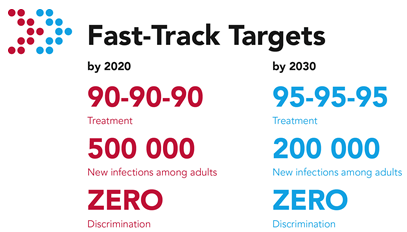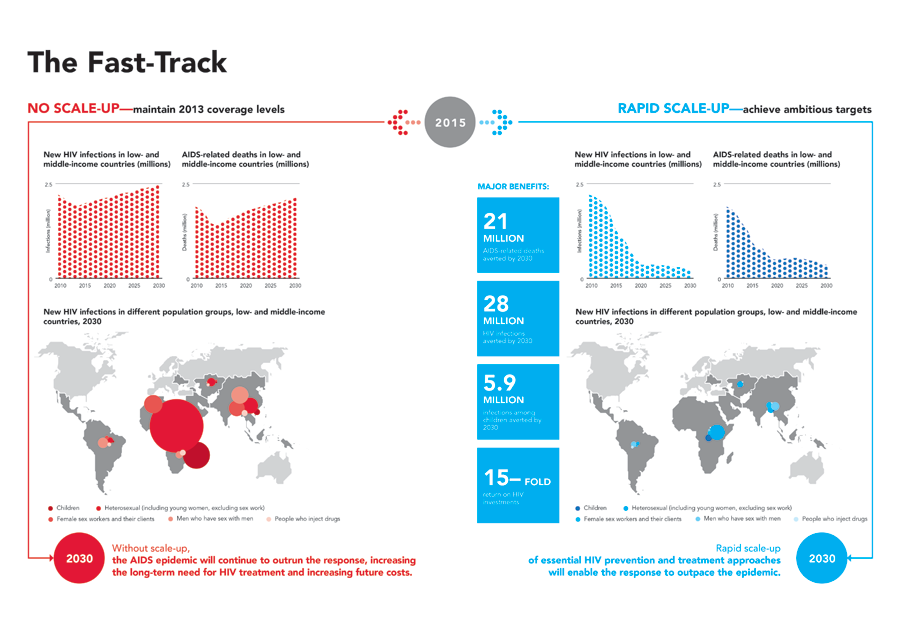If the world does not rapidly scale up in the next five years, the epidemic is likely to spring back with a higher rate of new HIV infections than today
GENEVA/LOS ANGELES, 18 November 2014—The Joint United Nations Programme on HIV/AIDS (UNAIDS) has announced that taking a Fast-Track approach over the next five years will allow the world to end the AIDS epidemic by 2030. The new UNAIDS report Fast-Track: ending the AIDS epidemic by 2030 outlines, that by taking the Fast-Track approach nearly 28 million new HIV infections and 21 million AIDS-related deaths would be averted by 2030.
“We have bent the trajectory of the epidemic,” said Michel Sidibé, Executive Director of UNAIDS. “Now we have five years to break it for good or risk the epidemic rebounding out of control.”
 The report was launched at the University of California, Los Angeles (UCLA), during an event hosted by David Gere, Director, UCLA Art & Global Health Center. The Executive Director of UNAIDS was joined by special guest Charlize Theron, United Nations Messenger of Peace and Founder of the Charlize Theron Africa Outreach Project.
The report was launched at the University of California, Los Angeles (UCLA), during an event hosted by David Gere, Director, UCLA Art & Global Health Center. The Executive Director of UNAIDS was joined by special guest Charlize Theron, United Nations Messenger of Peace and Founder of the Charlize Theron Africa Outreach Project.
Fast-Track Targets
The new set of targets that would need to be reached by 2020 include achieving 90-90-90: 90% of people living with HIV knowing their HIV status; 90% of people who know their HIV-positive status on treatment; and 90% of people on treatment with suppressed viral loads.
UNAIDS estimates that by June 2014, some 13.6 million people had access to antiretroviral therapy, a huge step towards ensuring that 15 million people have access by 2015, but still a long way off the 90-90-90 targets. Particular efforts are needed to close the treatment gap for children.
Other targets include reducing the annual number of new HIV infections by more than 75%, to 500 000 in 2020, and achieving zero discrimination. The targets are firmly based on an approach to leaving no one behind that is grounded in human rights and, if achieved, would significantly improve global health outcomes.
Massive and widespread progress has been made in responding to HIV and many lessons have been learned in how to programme efficiently and effectively to produce the best results for people.
This message was echoed by Ms Theron, who spoke to the students, researchers, policy-makers and advocates attending the launch event. "When young people have access to quality HIV health and education options, they make smart choices for their futures. Let’s make sure adolescents everywhere are empowered to be part of the solution to ending this epidemic," said Ms Theron. “Meeting UNAIDS Fast-Track Targets will ensure no one is left behind.”
Fast-Track: ending the AIDS epidemic by 2030 also highlights just how critical investment is to achieving these targets. Low-income countries will require a peak of US$ 9.7 billion in funding in 2020 and lower-middle-income countries US$ 8.7 billion. International funding support will be needed to supplement domestic investments, particularly in low-income countries, which are currently only funding around 10% of their responses to HIV through domestic sources. Upper-middle-income countries will require US$ 17.2 billion in 2020. In 2013, 80% of upper-middle-income countries were financing their responses to HIV through domestic sources.
“If we invest just US$ 3 dollars a day for each person living with HIV for the next five years we would break the epidemic for good,” said Mr Sidibé. “And we know that each dollar invested will produce a US$ 15 return.”
If sufficient investments are achieved, global resource needs will start to reduce from 2020. By 2030, the annual resources required in all low- and middle-income countries will decline to US$ 32.8 billion, down 8% from the US$ 35.6 billion needed in 2020. These resources will provide antiretroviral treatment to twice as many people in 2020 than in 2015.
Focus
The UNAIDS Fast-Track approach emphasizes the need to focus on the counties, cities and communities most affected by HIV and recommends that resources be concentrated on the areas with the greatest impact.
The approach outlines that particular efforts are needed in the 30 countries that together account for 89% of new HIV infections worldwide. To Fast-Track national responses in these 30 priority countries will require extensive mobilization of human, institutional and strategic international partners as well as significant commitments from both national and international sources. The importance of reaching people most affected by HIV is also outlined as key to ending the AIDS epidemic and concerns are raised about access to HIV services for people most in need.
|
In 2013, an estimated:
35 million [33.2 million–37.2 million] people globally were living with HIV
2.1 million [1.9 million–2.4 million] people became newly infected with HIV
1.5 million [1.4 million–1.7 million] people died from AIDS-related illnesses
By June 2014:
13.6 million people had access to antiretroviral medicines
|
UNAIDS
The Joint United Nations Programme on HIV/AIDS (UNAIDS) leads and inspires the world to achieve its shared vision of zero new HIV infections, zero discrimination and zero AIDS-related deaths. UNAIDS unites the efforts of 11 UN organizations—UNHCR, UNICEF, WFP, UNDP, UNFPA, UNODC, UN Women, ILO, UNESCO, WHO and the World Bank—and works closely with global and national partners towards ending the AIDS epidemic by 2030 as part of the Sustainable Development Goals. Learn more at unaids.org and connect with us on Facebook, Twitter, Instagram and YouTube.



 The report was launched at the University of California, Los Angeles (UCLA), during an event hosted by David Gere, Director, UCLA Art & Global Health Center. The Executive Director of UNAIDS was joined by special guest Charlize Theron, United Nations Messenger of Peace and Founder of the Charlize Theron Africa Outreach Project.
The report was launched at the University of California, Los Angeles (UCLA), during an event hosted by David Gere, Director, UCLA Art & Global Health Center. The Executive Director of UNAIDS was joined by special guest Charlize Theron, United Nations Messenger of Peace and Founder of the Charlize Theron Africa Outreach Project.
